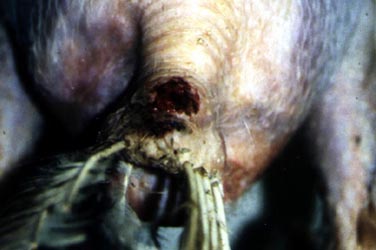
Cannibalism |
||
|
Cannibalism occurs when birds peck at the feathers, toes, heads, and vents of other birds. If there is bleeding and further pecking, it may result in the death of the bird. Vent pecking occurs often in laying hens. Young hens, especially if they are overweight, are susceptible to prolapse when their oviduct does not retract after the egg is laid, which induces pecking in the vent area. It may even lead to the pulling out of the intestines (pick-outs). There is more than one cause of cannibalism. It occurs more often in egg-type than in meat-type chickens. It may be caused by dietary insufficiencies such as salt, vitamins, or amino acids (protein components). Other factors include stresses such as feed deprivation, over-crowding, over-heating, inadequate ventilation and bright lighting. Eliminating these stresses can help to prevent or reduce cannibalism. If possible, injured or cannibalised birds should be removed from the flock for a period of time to allow for healing. Leaving them in the flock will provide stimulation for further pecking. One method to prevent or control cannibalism is by light manipulation. Reducing the light intensity and/or the duration of light in a day should help alleviate cannibalism. The use of red lights is also thought to help in some cases. The length of light exposure each day should not be reduced for laying hens. |
||
 |
||
| Cannibalism in a severely feather pecked hen. Photo: Jan Svedberg | ||